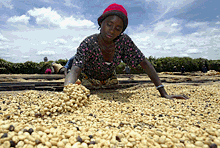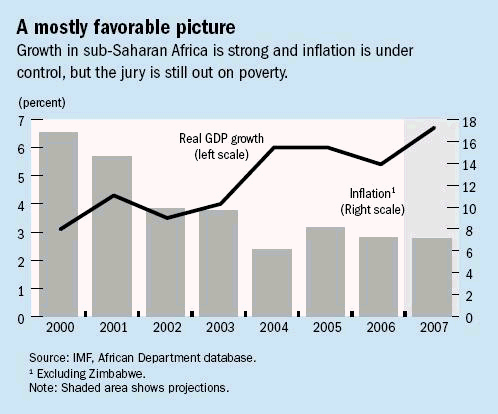SUB-SAHARAN AFRICA OUTLOOK

Typical street scene in Santa Ana, El Salvador. (Photo: iStock)
IMF Survey: African Growth To Edge Higher in 2007
April 23, 2007
- The commodity boom has improved the region's export prospects
- Growth and inflation could be adversely affected by further increases in oil prices
- To realize its growth potential, the region must implement additional reforms
Growth in sub-Saharan Africa (SSA) remained strong at 5-6 percent for the third consecutive year and is expected to edge up to 6-7 percent in 2007 with a renewed rise in oil production (see chart), says the IMF's latest regional economic outlook (REO).

Workers dry coffee beans in Kenya: African commondity producers are saving some of their increased revenue (photo: Antony Hjuguna/Reuters)
Even in oil-importing countries, growth should remain steady at about 5 percent. Inflation for the region is projected to remain unchanged at about 7 percent, with single-digit inflation in three-fourths of the countries. The higher growth trend in SSA is attributable to foreign demand, as well as to strong domestic investment and productivity gains supported by sound economic policies in most countries.
Although SSA governments "are spending more to reduce poverty and provide critical government services, financed in part by debt relief," the REO says it is too early to assess whether the higher growth has translated into lower poverty. At a press conference on April 13, Director of the IMF's African Department Abdoulaye Bio-Tchané said, "While overall growth has been strong, meeting the MDGs still seems unlikely. To reduce poverty by 50 percent, the growth rate will need to be at least 1, perhaps 2 percent more, and social and other obstacles to meeting the non-income MDGs have not been addressed." Increased aid flows would help in that respect, but the scaling up of aid promised at the 2005 Gleneagles summit has not yet materialized.

SSA's commodity producers have, unlike during past commodity booms, saved a portion of their increased revenue and must determine how and how fast to spend it in light of limited absorptive and implementation capacity. The bottom line is that they must use it productively and manage carefully the scaling up of spending because it risks putting substantial upward pressure on prices and the real exchange rate.
The commodity boom, according to the REO, has improved the region's export prospects. "The time may be ripe for SSA to reverse the long-term decline in its share of trade," Bio-Tchané said. But, although trade with Asia—China in particular—has expanded dramatically, SSA's exports are still dominated by oil and other commodities. Its inability to diversify is due largely to a lack of infrastructure and the costs of doing business. According to the REO, some progress has been made in developing functioning financial markets, often considered the "missing link" in facilitating private sector activity. Local currency debt markets can increase the efficiency and transparency of budgetary financing and facilitate the emergence of corporate bond markets.
Risks and challenges
The REO describes the risks to SSA's outlook as moderate and manageable and notes that policies in most countries support recent stabilization gains. SSA's outlook would be affected by a faster-than-anticipated slowdown in the global economy. Growth and inflation could also be adversely affected by further increases in oil prices and a larger-than-expected fall in nonfuel commodity prices. Some countries could also be affected by a shift in investor sentiment, reversing portfolio flows. Finally, the Darfur crisis in Sudan, the conflict engulfing Ethiopia and Somalia, the political problems of Cote d'Ivoire and Guinea, and the fallout from the Democratic Republic of Congo's recent elections all pose risks to the region, the report says.
To realize its growth potential, SSA must implement additional reforms. For example, to effectively absorb increased resources from aid and higher oil revenue, countries need to do a good job of coordinating fiscal and monetary policies. They should also institute reforms that ease absorptive capacity, increase the domestic supply response to higher spending and enhance productivity. These include liberalizing trade, reducing the costs of doing business, and making labor markets more flexible.







